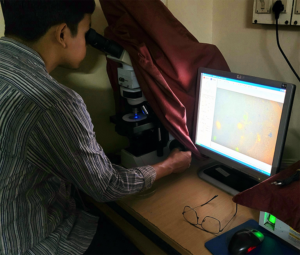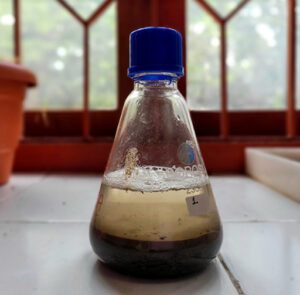Registered with the Registrar of Newspapers for India under R.N.I 53640/91
Vol. XXXI No. 2, May 1-15, 2021
Plastic pollution becomes a reality in Chennai
by Padmaja Jayaraman

Kaushik Dowarah observing microplastics under a microscope in Pondicherry University.
It is utopian to imagine a world without plastic, and it has its uses. At the same time, excessive utilisation of plastic without safeguards for disposal of waste can do immense harm. It is likely to cause various health issues affecting hormones, lungs, nerves, and the overall immune system. Sometimes, it may even lead to cancer.
Over the years there has been a felt need for more information on how Chennai fares with regard to microplastic pollution in the air. To find out about this, a group of researchers from Pondicherry University embarked on a mission to estimate the strength of this ‘enemy’ in the air over Chennai, proving that people are breathing plastic. It was found that South Chennai was more polluted by plastic than the North.
They found that the street dust contained plastic in the form of tiny microplastic particles in the city. “These are plastic particles which are smaller than five millimetres in size. They are formed due to the fragmentation and weathering of plastic objects in the environment as a result of various mechanical, chemical, and biological processes,” explains Kaushik Dowarah, one of the primary authors of the study. These pollutants are generated mostly out of plastic that goes to waste. In 2015, out of 407 million tonnes of plastic that was produced globally, three-fourth of it became waste, according to the United Nations Environment Programme.

Density separation of microplastics from street dust samples in Pondicherry University.
Microplastics in street dust indicate the urban environment of the city. “It means they are also present in the air we are breathing, as the particles that have settled in the dust are also likely to be resuspended in air. They may also resettle on household surfaces,” clarifies Dowarah. Children are more susceptible to inhale or ingest microplastics as they may play with dirty toys which have deposits of contaminated dust.
Urban road littering, surface abrasion of tyre treads, road paints, construction and building materials, artificial turfs as well as aeolian transport of debris are potential sources of microplastics in an urban setting, according to the research. The study used various scientific techniques to identify nine types of polymers that the microplastics contained viz. polyvinyl chloride (PVC), polyethylene-co-vinyl-acetate, HDPE, poly tetrafluoroethylene (PTFE), cellulose microcrystalline, lyocell, superflex-200, wax-1032, and AC-395.
PVC is used in packaging, floor and wall coverings, furniture coverings, etc. PTFE is used in non-stick pans. “A PVC door may undergo scratches and tear on the surface, maybe at a very microscopic level and hence produce microplastics,” simplifies the researcher.
The study involved sampling of street dust from sixteen locations in Chennai. According to Dowarah who was responsible for all the analyses of the study, the places included are some of the important hubs in terms of industrial, commercial, recreational, and residential aspects. Eight sampling points came under the northern region viz.Ambattur, Aminjikarai, Ayanavaram, Kasimedu, Koyambedu, Moolakadai, Poonamallee, and Sembium. The southern region included Anna Salai, MG Road, Guindy, Guindy Industrial Estate, Besant Nagar, Sardar Patel Road, Tidel Park, and Velachery.
The average microplastic abundance in these locations across the city was estimated to be 227.94 ± 89.82 particles per 100 grams of street dust sample. The lowest count of microplastics for a sample was recorded as 17 particles per 100 grams in Moolakadai in North Chennai, while the highest was 408 particles per 100 grams in Velachery in South Chennai. The average microplastic abundance in the areas in the Northern part of Chennai is 190.46 ± 83.38 particles per 100 grams of street dust; whereas for the southern part, it is 265.42 ± 76.76 particles. “It was not surprising. The southern part has commercial areas, malls as well as industries. It is an emerging IT hub. More ‘development’ means more ‘plastics’,” elucidates Dowarah about the microplastic pollution trend in South Chennai. Furthermore, North Chennai contains residential zones and traditional industries only. This explains the lesser extent of microplastic pollution in the zone.
Microplastics are way more toxic than one can imagine. On breaking down from larger fragments, they acquire a greater surface area, thus being a leeway for other toxic contaminants to sit on the particles. Together they can form inhalable toxins, leading to severe health hazards.
Health hazards caused by microplastics are not something unheard of. The presence of microplastics was discovered in seven species of fish in the coastal areas of Chennai by the National Centre for Coastal Research (NCCR), in March 2021. Microplastics were present in the gills of the fishes sold in Pattinapakkam. Indian Mackerel, Greater Lizardfish, Barracuda, Humphead Snapper, and Golden Snapper were other fish varieties that had microplastics in their guts. “What is in our air shall settle on the roads and other surfaces, which shall again get resuspended in air. From there, they [microplastics] make their way to other areas like food, sea, then marine organisms, back to our food again, and so on. In other words, the fish ingest microplastics, and are then caught by fishermen. Then they intrude on to our plates,” says the researcher from Pondicherry University.
If this situation of microplastic pollution persists, Dowarah feels that the quality of life is going to reduce. Nevertheless, he feels it is not checkmate yet. “There is hope. In the past three years, I have seen shopkeepers and customers being strict about carry bags. But this is not enough. Mere awareness among people is not going to stop the use of plastic,” remarks Dowarah. He urges the government to ramp up the recycling of plastics, ensuring that not a single plastic article is allowed to be left unattended in the environment. He feels that some revenue should be allotted for proper waste disposal systems, and to prevent the burning of plastics.
“Government and industrialists need to work together to push for eco-friendly alternatives. It is not prudent to stop the use of plastic without making a better alternative available. To achieve that, some important financial decisions need to be taken by the stakeholders, along with creating awareness among people,” recommends the researcher.

